Boulton's Birds - Part Eleven
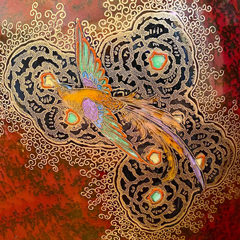
PARADISE BIRD & TREE with CLOUD
Designed by Enoch Boulton
by Harvey Pettitwith border artwork by Barbara Anne Lee
This is the eleventh in a series of sixteen articles on bird patterns introduced by Enoch Boulton during his tenure as designer and decorating manager at the Carlton Works from 1921/22 to 1930.
More Flights of Fantasy
PARADISE BIRD & TREE with CLOUD elaborates on PARADISE BIRD & TREE, its sister pattern, which I discussed in the previous article. Both patterns were introduced simultaneously. This extravagant concoction incorporates the 'cloud' originally devised for the slightly earlier SWALLOW & CLOUD pattern.
Pictured below is a FOOTED FRUIT decorated with PARADISE BIRD & TREE with CLOUD 3154, which employs an ORANGE ground.
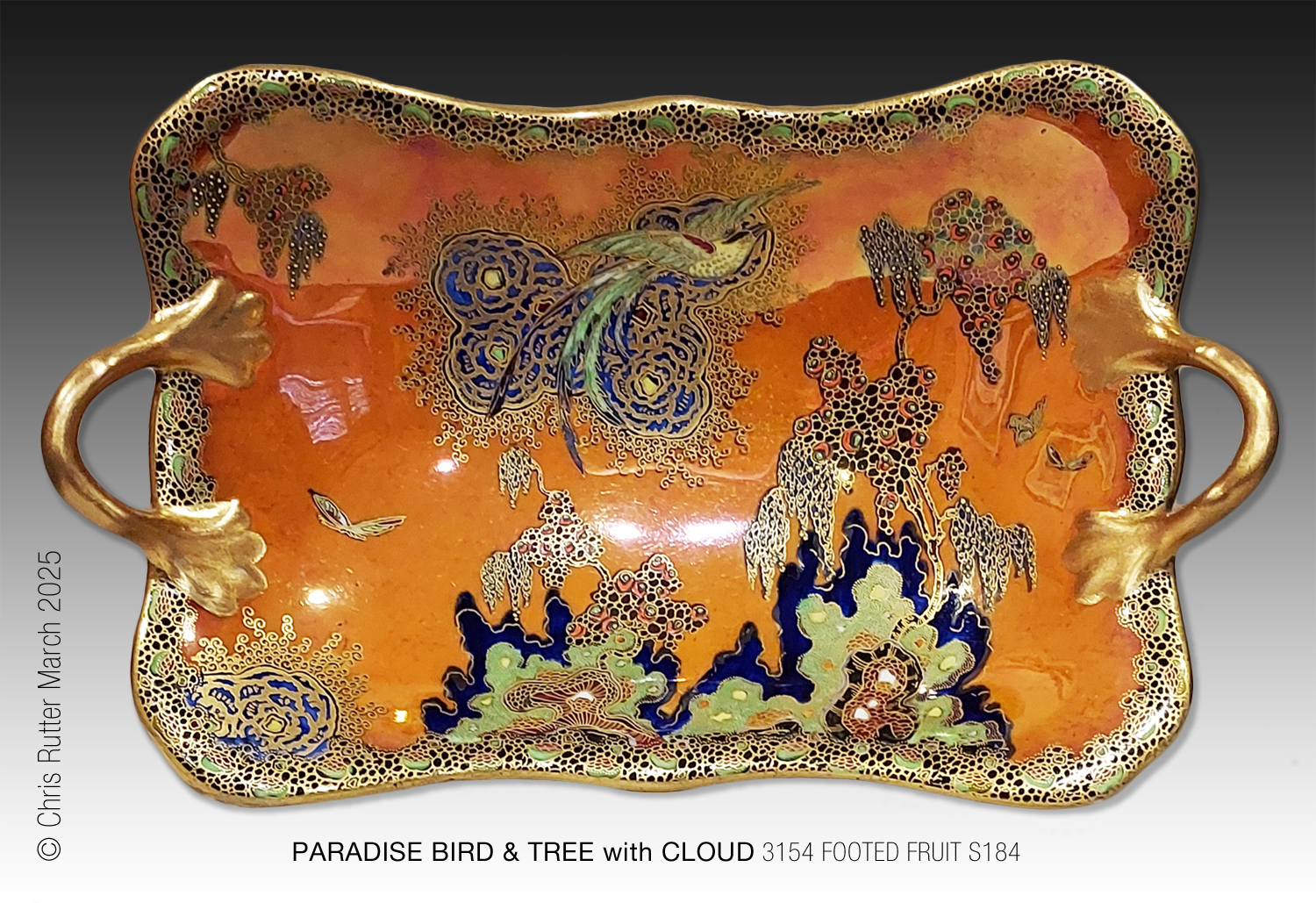
underglaze painted; blue cloud; re-printed in gold; RUBY lustre detail; raised enamels.
To return to this page, use your back button.
Because I covered the sister pattern, PARADISE BIRD & TREE, in the previous article, I will not repeat its description here. However, if you would like to know more about the related pattern's influences, constituent parts, and other details—all of which are relevant to PARADISE BIRD & TREE with CLOUD—you can access the previous article here.
Below, I show the first variant of PARADISE BIRD & TREE with CLOUD.
It was allocated the pattern number 3143. Here it decorates a large wide rimmed bowl, named COSMO in Carlton Wares shape records. It was given the shape number 468.

RUBY ground (lightly) stippled black; underglaze painted; black cloud; re-printed in gold; orange lustre detail; raised enamels.
To return to this page, use your back button.
The bowl centre is surrounded by Boulton's stylized Gongshi (rocks), from which small trees emerge—with dramatic results.
THE CLOUD

In my earlier article on Boulton's SWALLOW & CLOUD pattern, I discussed the 'cloud' motif and its delicate, filigree-like fringe. Below is a detail illustrating the fringe's intricate curlicues.
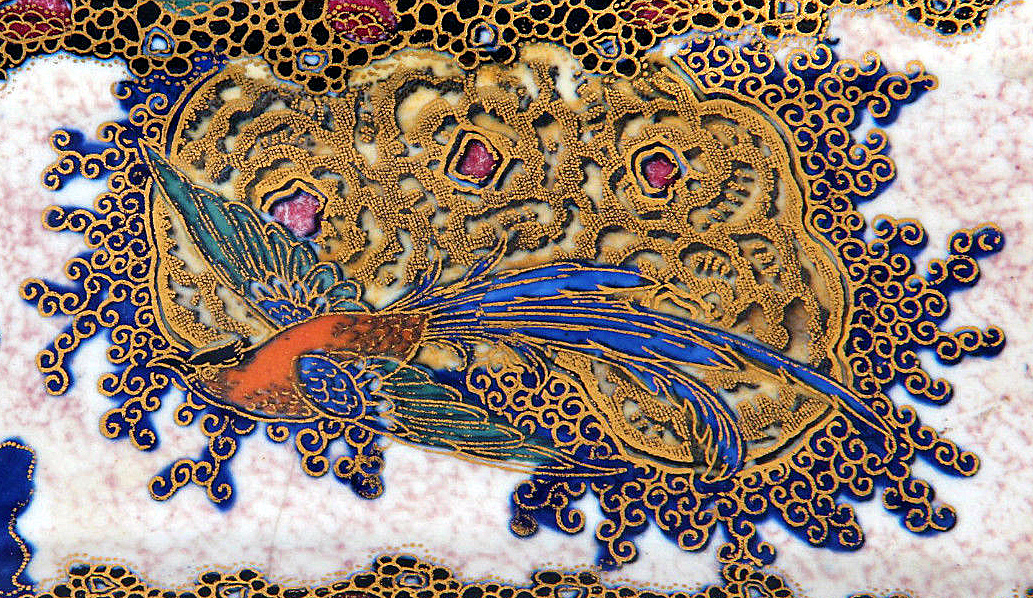
In that previous article, I suggested that the form of the fringe might have been inspired by so-called 'vermicelli' decorations found on antique or even ancient pottery.
But now, having found an image of the boards (covers) of an original 1914 edition of East of the Sun, West of the Moon illustrated by Kay Nielsen, and knowing that Boulton was influenced by Nielsen's work, I have another suggestion.
The boards of this lavishly produced book have gilt, tooled (embossed) designs also by Nielsen. On the right, I show part of the tooling on the front cover. It is this that I suggest is more likely to have been the source of the forms that Boulton uses to line his 'cloud'.
PARADISE BIRD & TREE BORDER
In the previous article on PARADISE BIRD & TREE, I also wrote about the pattern's accompanying border. Below, I repeat Barb's rendition of it.
To see how the border was decorated in various colours on this and several other patterns, click or tap on it to view more of Barb's excellent work.
Date of Introduction
In Carlton Ware's pattern records, the sister pattern, PARADISE BIRD & TREE 3149 is dated July 1927. Given that the first pattern number for PARADISE BIRD & TREE with CLOUD is 3143, and the two numbers are so close, we can be confident that it was also introduced in 1927.
Availability
Pattern records list nine variants of PARADISE BIRD & TREE with CLOUD.
The first variant, 3143, can be seen on the RUBY ground COSMO shape bowl shown above, as well as on the Rumidor and pen stand depicted below.
The pattern is found on post-World War II (1945) shapes, indicating it was available into the 1950s—either for export or, for a time, within the UK after restrictions were lifted in 1952. Between 1940 and 1952, the sale of decorated pottery in the UK was prohibited to prioritize exports and generate dollars to help pay off the war debt owed to the USA.
More Shapes
Let's explore some more shapes that employed this extravagant pattern, as well as more of its variants. Horace Wain, Enoch Boulton's predecessor, embraced the popular trend of the early 1900s—called 'Chinamania' at the time—and introduced many shapes inspired by Chinese forms. While some of these were retained during Boulton's tenure, the young designer—still in his twenties—created many new, original, and elegant shapes. Their simplicity provided the perfect counterbalance to Enoch's increasingly elaborate patterns.
Smoking Accessories
PARADISE BIRD & TREE with CLOUD was also used to decorate smoking accessories, such as cigarette boxes, humidors and ashtrays. Below is a footed cigarette box in the pattern on an unusual LACQUER YELLOW ground.

LACQUER YELLOW ground; underglaze painted; black cloud; re-printed in gold;
raised enamels.
Enter Matt Glaze

The principal feature of most of these new, attractive patterns was their use of a matt glaze, which has a less reflective, silky appearance. Early examples employed a reduced palette of blues, ochres, purples and pinks.
The first HANDCRAFT pattern was Enoch Boulton's Aster 3234, which featured simple flower heads, much in the style of the Dutch Gouda Pottery, which from the 1920s onwards, specialised in the use of matt glazes—as did Poole Pottery in Dorset. Wedgwood too adopted these attractive finishes, most notably on designs by Keith Murray introduced in the early 1930s. Such finishes were clearly en vogue at this time.
PARADISE BIRD & TREE with CLOUD 3252 was one of the first Best Ware patterns to use a matt glaze. This variant must also have been available from 1928 onwards. Below is a footed cigarette box that employs the silken finish.
It is interesting to compare the placement of elements of the pattern on this example with the one above on the LACQUER YELLOW ground.

White ground, stippled PINK; underglaze painted; blue cloud; matt glaze;
re-printed in gold; on-glaze RUBY and ORANGE lustre detail.
Below, I show a Rumidor, the trade name for tobacco jars that infused rum into its contents by means of a special insert inside the lid. According to adverts from the 1930s, the Rumidor was marketed in Europe by Alfred Dunhill. You can read about them in an article I wrote in 2010 by clicking or tapping here.

RUBY ground stippled black; underglaze painted; black cloud; re-printed in gold;
orange lustre detail; raised enamels.
Desk Pen Stands
As I mentioned in the previous article, according to Carlton Ware's pattern records, the last five of the twenty-eight variants of PARADISE BIRD & TREE were devised specifically for desk pen stands. The sister pattern PARADISE BIRD & TREE with CLOUD, was also deemed suitable for pen stand decorations.
Below, I show two examples. The first was made for the Chicago-based
Wahl-Eversharp, makers of high-quality writing instruments. According to the Fountain Pen Network, Wahl also manufactured pens for the UK market in Newhaven, East Sussex. It is possible that a resourceful Carlton Ware salesman for the South of England approached the company to propose a collaboration; however, the initiative may equally have come from Wahl.
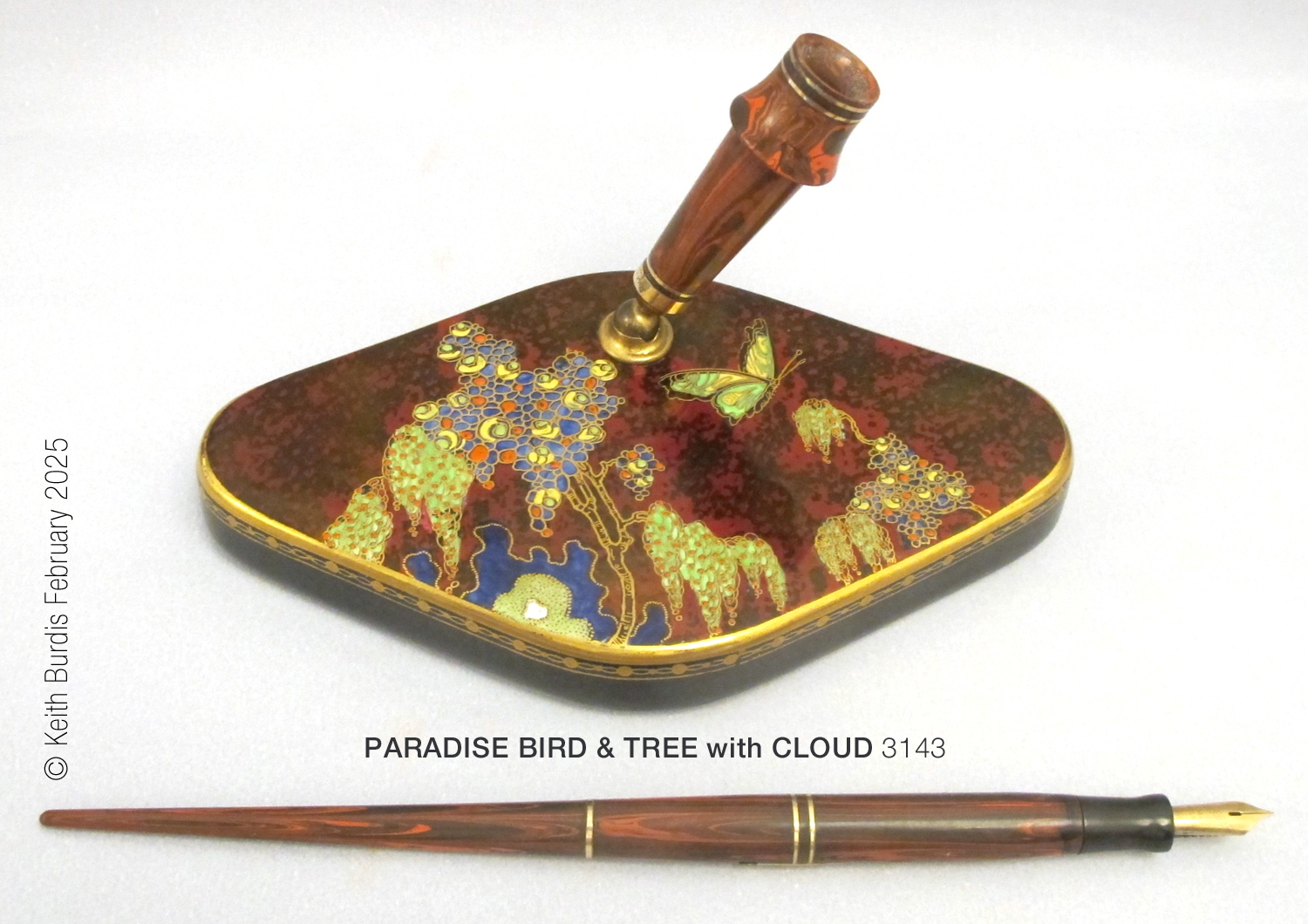
RUBY ground stippled black; underglaze painted; re-printed in gold; raised enamels.
CAMEO BEAD as border.
Despite the pattern name, notice that on this shape there is no room for the bird or cloud!
The pen stand below was made for Onoto, another pen maker, and a brand name invented in 1906 by Thomas De La Rue & Company—best known as the world's largest commercial banknote printer. At the time of pen stand production, their head office was in Bunhill Row, London EC1, which was bombed out in the Blitz of 1940.

stippled ORANGE ground; underglaze painted; re-printed in gold; raised enamels.
CAMEO BEAD as border.
Although this example is assigned a pattern number for PARADISE BIRD & TREE with CLOUD, once again there is no room for the cloud!
Most pen stands used the simple CAMEO BEAD originally designed as a border for the earlier CAMEO pattern. Barb has drawn this for us below.
![]() © Barbara Anne Lee 2023
© Barbara Anne Lee 2023
The images above show two different pen stand shapes, though Carlton Ware produced at least six, suggesting that they must have been popular, at least for a short time. Carlton Ware's surviving records do not specify for whom they were made, but examples tell us that these luxurious desk accessories were not only made for Onoto and Wahl, but also for Parker Pens, who, it appears, in advance of others, began marketing their ceramic desk pen stands in 1928.
With so many decorating techniques employed, PARADISE BIRD & TREE with CLOUD would have been an expensive pattern to produce, so costly to buy.
It is found on many other shapes, vases, jugs and coffee sets, for example, so must have been popular with those having deep pockets.
V1 March 2025. If more accurate information comes to light, I will update this page.
Thanks must go to Chris Rutter and Keith Burdis for providing excellent images.
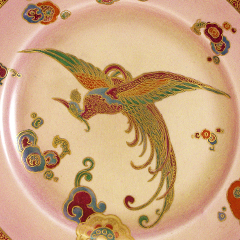
The next article in this series will be about CHINESE BIRD.

